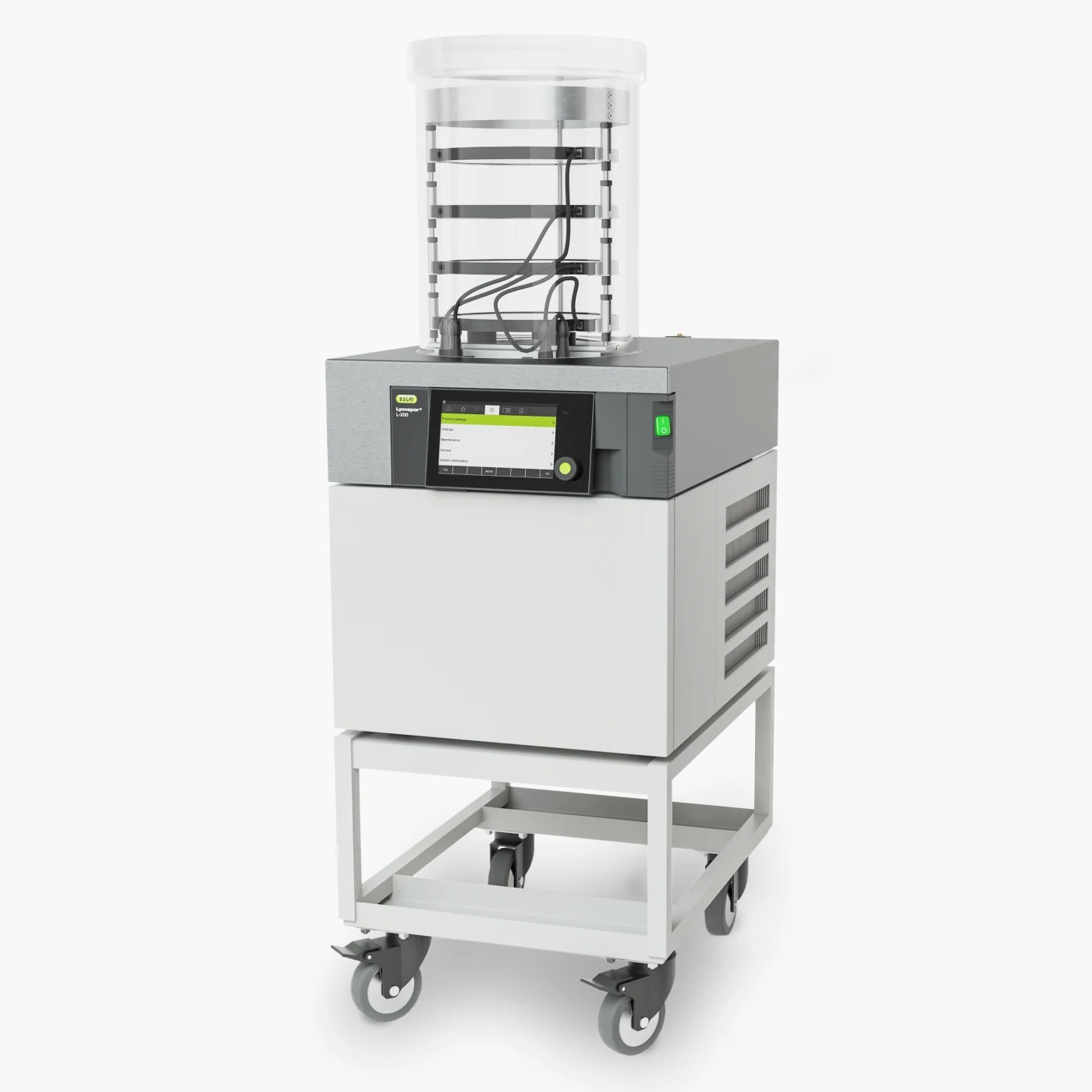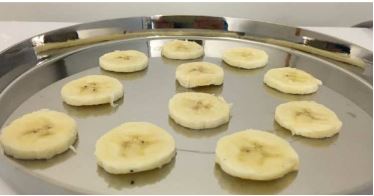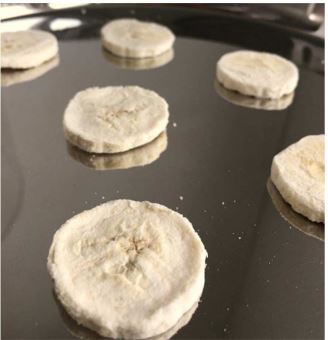Blog Standard

Optimizing the Lyophilisation Process for Banana Slices Using BUCHI Lyovapor™ L-200
Freeze drying, also known as the lyophilisation process, is a highly efficient and gentle food drying technology used for preserving delicate food items without altering their taste, texture, or nutritional value. In this application, the focus is on the freeze drying of banana slices using advanced laboratory freeze drying equipment. This method involves freezing the food and then removing water through sublimation under reduced pressure. The freeze dried food obtained retains its original structure and is ideal for long-term storage. Commonly used in the production of freeze dried food products such as coffee, fruits, and vegetables, freeze drying offers distinct advantages in quality preservation. This study demonstrates the banana lyophilization process using the BUCHI Lyovapor™ L-200 Pro and evaluates the results using moisture analysis.
Equipment Used
- BUCHI Lyovapor™ L-200 Pro
- BUCHI Lyovapor™ Software
- Deep Freezer -40°C, tritec HANNOVER
- Stainless steel tray
- Mettler Toledo HR73 Halogen Moisture Analyser

BUCHI LyovaporTM L-200
Materials
- Fresh banana slices, sourced from a local supermarket.
Experimental Methodology
1. Sample Preparation
Fresh bananas were sliced into uniform pieces approximately 5 mm thick. A total of eleven slices were evenly arranged on a stainless steel tray and placed into a deep freezer at -40°C (tritec HANNOVER) overnight to ensure thorough freezing. An alternative storage temperature of -20°C may also be used, depending on available infrastructure.

Figure 1: Tray with fresh cut banana slices.
2. Freeze Drying with BUCHI Lyovapor™ L-200 Pro
After 24 hours of deep freezing, the frozen banana slices were transferred into the Lyovapor™ L-200, a high-performance lyophilisation machine designed for precise food drying technology applications. Using the Lyovapor™ Software, both the primary and secondary drying phases were programmed.
| Drying chamber type | Standard | Safety temperature below collapse [°C] | Inactivated |
|---|---|---|---|
| Sample collapse temperature [°C] | Inactivated | Gas type | Ambient air |
Table 1: General settings for drying of banana slices in LyovaporTM L-200.
During primary drying, water removal from banana occurs via sublimation, while secondary drying eliminates adsorbed moisture. The shelf temperature was maintained below 25°C throughout the process to avoid sample collapse. Ambient air was used as the drying gas.
| Step | 1 | 2 | |
|---|---|---|---|
| Phase | Primary Drying | Secondary Drying | |
| Time | hh:mm | 12:00 | 03:00 |
| Temperature set point | °C | 25.0 | 25.0 |
| Temperature gradient | °C/min | 0.07 | 0.00 |
| Pressure type | Regulated | Regulated | |
| Pressure set point | mbar | 0.370 | 0.100 |
| Safety pressure | mbar | 1.500 | 1.500 |
| Safety pressure duration | sec | 10 | 10 |
Table 2: Parameters of the primary and secondary drying steps, set on the LyovaporTM Software.
3. Halogen Moisture Analysis
Post freeze drying banana slices, residual moisture content was measured to determine drying efficiency. Three banana slices were ground and quickly transferred (within 30 seconds) into the Mettler Toledo HR73 Halogen Moisture Analyser, a reliable instrument for moisture analysis of dried fruits. The analysis was conducted at 110°C, using a switch-off criterion of 5 (defined as a change of less than 1 mg in 140 seconds).
| switch-off criterion | 5 |
| Drying temperature [°C] | 110 |
Table 3: Moisture analyser settings

Figure 2: Tray with banana slices after freeze drying
Results and Discussion
1.Visual Evaluation
As shown in comparative images, the freeze dried banana slices maintained their original shape, color, and size, indicating minimal structural change during the process. This confirms the effectiveness of the BUCHI Lyovapor™ L-200 in preserving physical properties of the sample.
2. Moisture Content Determination
Moisture analysis results are summarized in the table below: All samples exhibited moisture contents below 3.14%, with an average water removal from banana of over 95.92%. The initial moisture content of the fresh banana was 76.97 ± 1.24%.
| Banana slice | Weight of freeze dried sample [g] | Weight of halogen dried sample [g] | Moisture content [%] |
|---|---|---|---|
| 1 | 0.606 | 0.587 | 3.14 |
| 2 | 0.843 | 0.818 | 2.97 |
| 3 | 0.794 | 0.770 | 3.02 |
Table 4: Results of the moisture analysis after freeze drying with LyovaporTM L-200.
Advantages of Freeze Drying Banana Slices
- Maintains flavor, color, aroma, and nutritional integrity.
- Eliminates surface hardening.
- Produces porous, lightweight freeze dried food that is easily rehydrated.
- Reduces transportation costs due to lower weight and volume.
- No preservatives or additives required.
Limitations
- Exposure to ambient air may lead to rapid rehydration.
- Requires vacuum-sealed or nitrogen-filled packaging.
- Fragile texture may lead to cracking during handling.
- Freeze drying is time and energy intensive, resulting in higher operational costs.
Conclusion
This study illustrates that the banana lyophilization process, when carried out using the BUCHI Lyovapor™ L-200 Pro, results in highly efficient water removal from banana slices while maintaining structural integrity. Supported by accurate measurements from the Mettler Toledo HR73 Halogen Moisture Analyser, the process ensures superior-quality freeze dried food products. The integration of the BUCHI Lyovapor™ Software provides precise control and reproducibility, making this method ideal for both research and industrial applications in food drying technology.
Inkarp Instruments is India’s leading distributor and trusted service partner for Buchi products. Driven by a commitment to innovation and excellence, Inkarp delivers cutting-edge scientific equipment and dependable support to researchers nationwide.
References:
1. G. W. Oetjen; Freeze drying; Ullmann's Encyclopedia of Industrial Chemistry (2004).
2. https://nuts.com/driedfruit/freeze dried/
3. http://www.chaucerfreezedried.com/
4. https://www.northbaytrading.com/dried-fruit/freeze dried-fruit/
5. H. Tse-Chao Hua, L. Bao-Lin, Z. Hua; Freeze drying of Pharmaceutical and Food Products, Woodhead Publishing Series in Food Science, Technology and Nutrition, pages 141–169 (2010).

